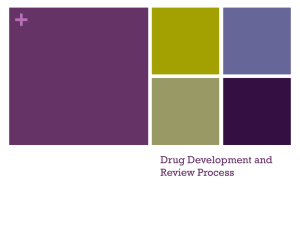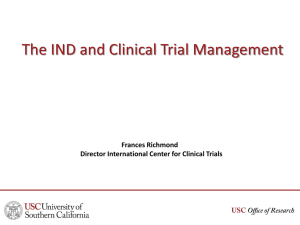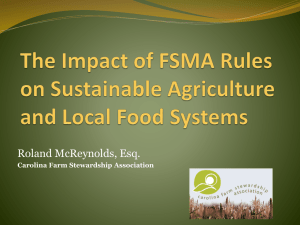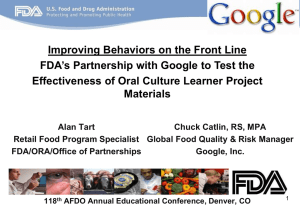Good Agricultural Practices (GAP)
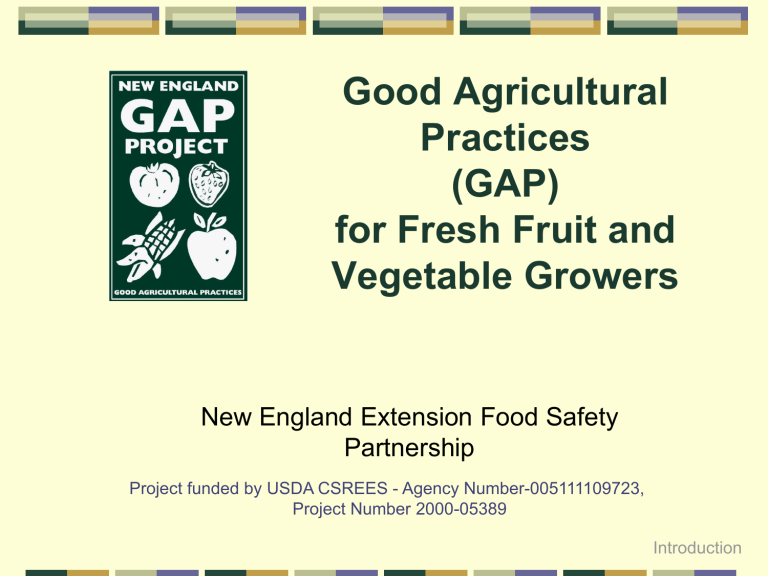
Good Agricultural
Practices
(GAP) for Fresh Fruit and
Vegetable Growers
New England Extension Food Safety
Partnership
Project funded by USDA CSREES - Agency Number-005111109723,
Project Number 2000-05389
Introduction
Good Agricultural Practices
(GAPs)
A “PREVENTION” FOCUSED
FOOD SAFETY MANAGEMENT
PROGRAM
The goal is to reduce microbial risks in fresh or minimally processed fruits and vegetables — making produce safer.
FDA Voluntary Program
Guidance for Industry
CFSAN/FDA
1998
GAP – Why?
Consumption of fresh produce steadily increasing for health.
Increases in the number of produce associated with foodborne disease outbreaks in the U.S.
Produce associated outbreaks per year more than doubled from 1973-1987 and 1988-1998.
A variety of fruits and vegetables implicated-domestic and imported
CDC estimate, 1990-2003, 12% foodborne outbreaks linked to fresh produce*
Pathogens normally associated with animal origin on fruits and vegetables
FDA/CFSAN. 2004. 2004 Action Plan. http://www.cfsan.fda.gov/~dms/prodpla2.html
Smith DeWaal, C and others. 2006. Food Protection Trends. 26(7):466-473.
Fruit/Vegetable Outbreaks: Agents and Origin of Produce
1990 – 1998: Origin: 75.3% outbreaks of related to produce grown domestically
1990-2004: 639 documented outbreaks (inc.prepared), 31496 cases
1988 – 1998: Major bacterial outbreaks caused by Salmonella and
E.coli. Other identified Shigella, Campylobacter and others.
1988 – 1998: Parasitic outbreaks caused by Giardia (3) and
Cyclospora (5).
1998 – 2004: 25% foodborne illness outbreaks implicated with freshcut produce
1998 – 44 outbreaks in produce; 2004 – 85 outbreaks
Since FY2000 Traceback: FDA investigated 57 outbreaks, 47 involving fresh produce
From Food Safety Begins on the Farm. Robert B. Gravani and Elizabeth A. Bihn. Cornell University.
CDC Foodborne outbreak survellience
FDA 2006. Draft Guidance to Minimize Microbiological Hazards Fresh-cut Fruits and Vegetables. http://www.cfsan.fda.gov/~dms/prodgui2.html
IAFP Rapid Response Symposium. Ocotber 6, 2006.
CSPI. 2006. Behind CSPI’s Outbreak Data: A look at Produce Outbreak Numbers
Fruit/Vegetable Outbreaks: Agents and Origin of Produce
1996-2006: 71 outbreaks due to produce source alone
(not prepared) – tomatoes, leafy greens, melons, raspberries, green onions, almonds, basil, parsley
1998-2006: 18 outbreaks, fresh cut
1995-2006: 10 outbreaks due to leafy greens (primarily
CA, E. coli 0157:H7 )
1998-2006: 6 outbreaks due to tomatoes (primarily east coast -FL, VA, OH Salmonella )
1998-2006: FDA investigated outbreaks associated with ~20 fresh produce commodies. More then half related to leafy greens, tomatoes and melons.(*)
Guzewich, J. 2007. Safety of produce. Presented 2007 NEFDOA conference. Warwick RI .
Michelle A Smith. 2007. Publlic hearling on safety of fresh produce. CFSAN/FDA. www.fda.gov/ohrms/dockets/dockets/07n0051/07n-0051-ts 00004.smith.pdf. *
Caroline Smith Dewaal and Farida Bhuiya. 2007. Presented at IAFP. Center for Science in the Public Interest
Outbreaks – Domestic or Foreign Source?
Animal source
21 E. coli 0157:H7
28 Salmonella spp.
Source
27 Domestic
7 Foreign
15 Unknown
Human source
16 Cyclospora
3 Hepatitis A
2 Shigella
Source
1 Domestic
12 Foreign
8 Unknown
Guzewich, J. 2007. Safety of produce. Presented 2007 NEFDOA conference. Warwick RI .
Ongoing Challenges
Leafy Greens
Tomatoes
Green Onions
Cantaloupe
Parsley, Cilantro
From R. Buchanan presentation. FDA
Wes Kline, From Rutgers NJ
Agricultural Experiment Station
US Food and Drug Administration , 2007
FDA can shut down an entire industry
Wes Kline, From Rutgers
NJ Agricultural
Experiment Station
2006 Outbreaks/Recalls – A Banner Year
Spinach – September, 2006:
204 cases E. coli 0157:H7
31 cases HUS
104 hospitalizations
3 deaths
26 states
Source – Salinas Valley, CA
Cattle manure from California Ranch??
Shredded Lettuce (Taco Bell) – December, 2006:
71 cases E. coli 0157:H7
8 cases HUS
53 hospitalizations
0 deaths
5 states
Source – still under investigation, Central Valley, CA???
2006 Outbreaks/Recalls – A Banner Year
Lettuce Recall – October, 2006
Nunes Lettuce, Salina, CA
Foxy Brand
E. coli contamination of irrigation water
Tomato – November, 2006
183 cases, Salmonella typhimurium
21 states
Served in restaurants
100 cases, Salmonella typhimurium
19 states
Cantaloupe Recall – November, 2006
Rio Vista, Ltd., Rio Rico, AZ
Llano, Nature’s Partner brands
Salmonella
Foodborne Ilnesses from Leafy Greens on the Rise (www.foodhaccp.com, 3/08)
1973 – 2006: significant increase outbreaks
involved in 5% of all outbreaks
norovirus (60%), salmonella (10%) and E.coli (9%)
From 1986 – 1995
consumption increased 17% over previous decade
foodborne disease increased 60%
From 1996 – 2005
consumption increased by 9%
foodborne disease increased by 39%
Increased consumption can’t explain it all!!
ICEID 2008. International Conference on Emerging Infectious Diseases. March 16-19, Atlanta Georgia.
Updates – Salmonella Saint Paul -
Jalapeno Peppers/2008
4/14/2008 –8/16/2008
1,442 ill, 43 states, DC and Canada
June/July – FDA: Certain tomato types implicated.
Specified areas to purchase from
June/July – FDA lifts tomato advisory, implements
Jalapeno pepper advisory
August – Traceback – distributor in Texas, peppers from Mexico. Pathogen found in irrigation water
Cost to tomato industry????
Updates
Peanuts and peanut products
9/1/2008 – 2/24/2009
Salmonella typhimurium
691 persons, 46 states
5 deaths
2100 + recalls
2006: Food commodities associated with largest illness numbers :
Poultry (21%), Leafy vegetables (17%), fruits or nuts (16%)
Produce (fresh, canned, processed) – 19.7 million illnesses, $1,960/case (higher then average) and $39 billion annually economic losses (CDC survellience system)
Source: produce safety project.org
1998-2007: Confirmed Illnesses
Seafood
Produce
Poultry
838 outbreaks 7,298 cases
684 outbreaks 26,735 cases
538 outbreaks 13,498 cases
Fruits 111 3,871
Vegetables 228
Dishes
Beef
Pork
345
11,197
11,667
428 outbreaks 9,824 cases
200 outbreaks 4,934 cases
CSPI, 2009 Outbreak Alert!
Updates
Produce Safety Project: www.ProduceSafetyProject.org
United Fresh Produce Association: www.unitedfresh.org
Food Safety Resource center
What are the Issues?
The Consumer
Increase in “at risk” populations
Awareness
Activism and concerns/perceptions
Buyer demands
Health concerns
????
The Micro World
Increase “virulence” and adaptation
Better detection
Technology/transportation
Global food supply
Media
Approaches to Food Safety
Become proactive —anticipate challenges
Do your own “audit”. Take notice.
Make communication a priority
Everyone —from farm to table—needs to take responsibility for food safety. We need to talk with each other and work together to improve the safety of our food supply
We need to inform and educate the industry and the public about public policy issues and risk analysis
Wes Kline, From
Rutgers NJ Agricultural
Experiment Station
What Are the Potential Sources of On-
Farm Contamination?
Soil
Irrigation Water
Animal Manure
Wild and Domestic Animals
Inadequate Field Worker Hygiene
Transport Containers
(field to packing facility)
Wash and Rinse Water
Inadequate Processing Equipment Cleaning and
Sanitation -equipment used to soak, pack, or cut produce
FDA/CFSAN Conclusions
Animals and contaminated water implicated
Pre-harvest/harvest phases of production most likely opportunity for contamination
Post-harvest practices may contribute to spread
Pre-harvest/post-harvest sanitation treatments on produce – little effectiveness. Antimicrobial applications impact adequate reduction, quality implications
Guzewich, J. 2007. Safety of produce. Presented 2007 NEFDOA conference. Warwick RI
Response
FDA, 2004 : Produce safety from production to consumption:
2004 Action Plan to Minimize Foodborne Illness Associated with
Fresh Produce Consumtion. http:/www.cfsan.fda.gov/~dms/prodpla2.html
FDA, 2007 : New guidance for safe production of fresh-cut fruits and vegetables: http://www.cfsan.fda.gov/~dms/prodgui2.html
FDA, 2006: Lettuce Safety Initiative http://www.cfsan.fda.gov/~dms/lettsafe.html
FDA, 2006: Guidelines for the Fresh Tomato Supply Chain http://www.cfsan.fda.gov/~dms/tomatsup.html
Industry initiatives – CA, AZ 3,000 growers calling for mandatory
GAP (Food Protection Report, Nov.2006, 22(11)).
Response (con’t)
USDA , May 31, 2006 . Requirement for GAP verification for all fresh products supplied to USDA programs beginning July 1,
2007 with voluntary audits beginning July1, 2006. Suppliers meeting GAP verfication listed on USDA GAP/GHP website.
CSPI , Citizen Petition, November 15, 2006 . Urging FDA to issue standards and regulations to ensure safe food production of fresh fruits and vegetables. Requesting mandatory hazard control programs for farms and processors in the GAP areas such as manure, water and sanitation.
California legislation , February 2, 2007 – Leafy green vegetables
CA Department of Food and Agriculture , February 7, 2007 –
Leafy Green Marketing Agreement – inspection program for handlers of leafy greens certified by CDFA.
Response (con’t)
FDA , June 12, 2007 . Tomato safety initiative to reduce tomato-related foodborne illnesses due to Salmonella . To begin with VA farms and packing facilities as to degree implement GAP and GMP’s.
FDA , September, 2008 . Original guidance document revisited for updating in response to 10 years of outbreaks.
Food Safety Enhancement/Modernization Acts 2009 .
Proposed, House and Senate. Incorporates all food products. Proposed requirement for food safety plans and/or standards for fresh produce.
Response (con’t)
FDA, 2/23/2010 : Request for comments on preventive controls for fresh produce
Risk factor identification
Assessment hazards and pathways to contamination
Preventive controls for hazards
Microbial testing
Postharvest operations and GMP’s
Records and other documentation
GAP integration
Role of standards for domestic and foreign growers/processors
FDA Food Modernization
Act of 2010
New Food Safety Standards and Regulations: Impact on the Produce Industry
Some Key Expectations
Registration and re-registration
Produce Safety Standards – GAP/Food Safety Plan at
Harvest: High risk foods?
Preventive Control Food Safety Plans for processors, wholesalers and distributors (HAACP-type)
Flexibility for small farmers and businesses
Food defense as part of plan
Records
Traceability provisions
Impact at retail – FDA reportable food registry
FDA Mandatory recall authority
Other – Importer accountability, inspections, 3 rd party etc.
Registration
Not for harvesters
Clarification of on-farm activities that would require registration
Processors, wholesalers, distributors
Extension of Public Health Security and
Bioterrorism Preparedness and Response
Act of 2002
Re-registration every even-numbered year – every 2 years
Introduction of food into commerce without registration - prohibited
Produce Safety Standards
Address growing, harvesting, sorting, packing/storage
Science-based minimum standards for
Soil amendments
Hygiene
Packaging
Temperature controls
Animals
Water
High Risk Produce - prioritize
Produce Safety Standards -Timeline
Proposed rule = 1year
Final rule = 1 year
Phase in for Farmers
Large farms - immediately
Small farms – 1 year from regulations
Very small farms – 2 years from regulations
What will the standards look like
Some kind of food safety plan, based on GAP
?
Preventive Controls – HACCP-type
Hazard evaluation for reasonable biological, chemical, physical, pesticide etc. hazards written
Include bio-security issues
Implement preventive controls to prevent, minimize or eliminate hazard - CCP
Includes sanitation, training, recalls, GMPs etc.
Monitor controls, Corrective Actions, Records,
Verification steps to make sure plan working
Preventive Controls – Timeline
Proposed rule = 9 months
Implementation = 1.5 years
Large farms = immediately
Small farms = 6 months from effective regulation date
Very small farms = 18 months from effective regulation date
What will the FDA regulations look like?
Seafood HACCP and Juice Regs
Flexibility for Small Farmers
Produce safety standards
3 yr average sales < $500,000 ALL food
Distribution intrastate or within 275 mi. radius
Majority distribution end-users e.g. directly to customers, restaurants or retail food (NO distributors)
Product label: name/place business, if no label provided through placard at a retail, for example
Exemption can be withdrawn by FDA with reason of contamination
Flexibility for Small Businesses
Preventive Controls/Food Safety Plans
Exclusions:
FDA must define small and very small business
Warehouses storing raw agricultural commodities for further processing
Facilities subject to produce safety standards
Processors subject to other HACCP regulations
Dietary supplements
Alcohol-related facilities
Flexibility for Small Businesses
Preventive Controls/Food Safety Plans
Exemptions (still must register)
3 yr average sales < $500,000 ALL food
Distribution intrastate or within 275 mi. radius
Majority distribution end-users e.g. directly to customers, restaurants or retail food (NO distributors)
Product label: name/place business, if no label provided through placard at a retail, for example
Must document applying controls or in compliance with other state, local requirements
Exemption can be withdrawn by FDA with reason of contamination
Flexibility But……
Buyers Requirements:
Food safety applies to all sizes!
Produce Safety Alliance
Steering committee : Cornell (lead) FDA,
USDA, Universities, growers, shippers, produce trade alliances, USDA NRCS, NASDA
Key elements : Standardized curriculum, information bank, Website, Educational
Collaborative Network, Assessment outreach tools, Train-the-trainer
Seafood HACCP Alliance
The New England GAP Program for
Small Producers of Fruits and
Vegetables ( based on the
FDA/USDA Guide) addresses these sources of contamination.
Be sure to think about the following when developing a GAP program for your operation:
Water safety
Safe use of manure and biosolids
Worker health and hygiene
Sanitation in the field, packing area, and PYO operations
Temperature control
Traceback
Liability Insurance
Farm Family Insurance : Liability credit of ~ 10%
Contact John Howard
Useful websites
Penn State University: http://foodsafety.psu.edu/gaps/ http://extension.psu.edu/food-safety/farm/resources
Joint Institute of Food Safety and Applied Nutrition (JIFSAN): http://jifsan.umd.edu/training/gaps_manual.php#en
Kentucky Department of Agriculture http://www.kyagr.com/marketing/gapresources.htm
Cornell National GAP Program education materials: http://www.gaps.cornell.edu/
UC Davis GAP information http://ucce.ucdavis.edu/files/filelibrary/5453/4362.pdf
Good general information about field harvest and packing http://postharvest.ucdavis.edu/index.html
Postharvest technology research and information center http://ucce.ucdavis.edu/files/filelibrary/5453/4369.pdf
Chlorination in the Production and Postharvest Handling of Fresh Fruits and
Vegetables http://www.umassextension.org/nutrition/index.php/programs/foodsafety/programs/good-agricultural-practices/gap-manual
University of Massachusetts
Food Safety Partnership
New England Cooperative Extension Food Safety Specialists
From:
University of Connecticut
University of Maine
University of Massachusetts
University of New Hampshire
University of Rhode Island
University of Vermont
Other Representatives:
State Agriculture Divisions/Departments
USDA Agencies (Farm Service Agency, ASCS, NRCS)
Farm Bureau
Growers Associations
Cooperative Extension Agricultural Specialists/Agents



